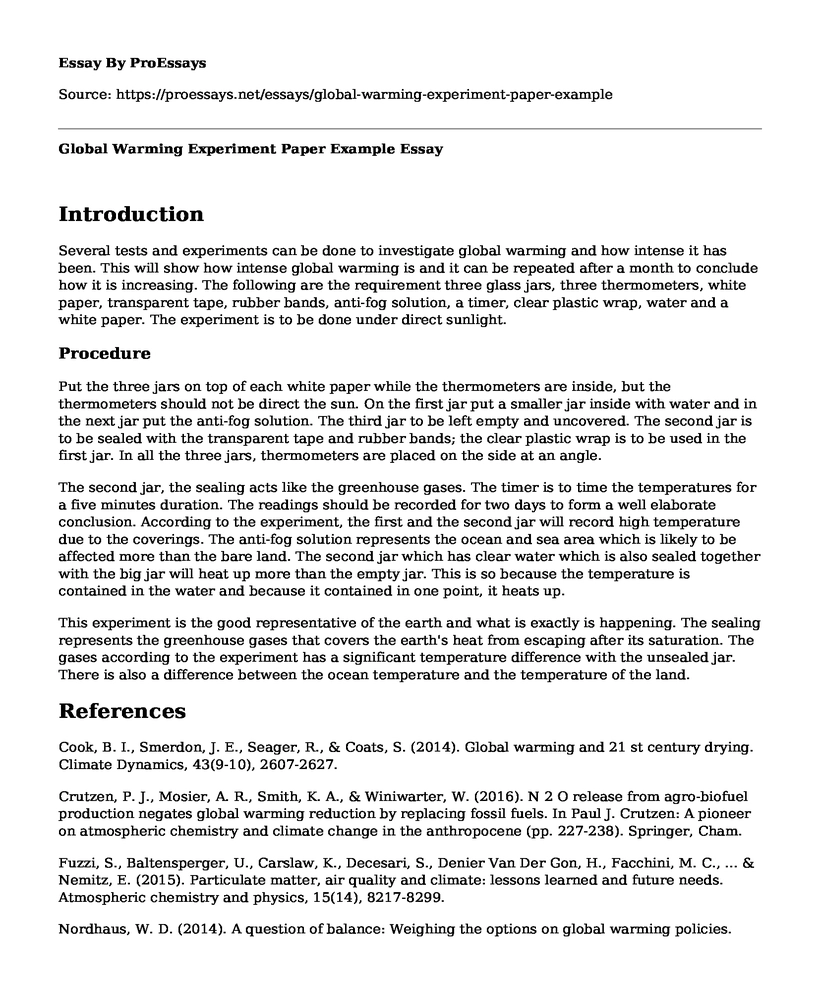Introduction
Several tests and experiments can be done to investigate global warming and how intense it has been. This will show how intense global warming is and it can be repeated after a month to conclude how it is increasing. The following are the requirement three glass jars, three thermometers, white paper, transparent tape, rubber bands, anti-fog solution, a timer, clear plastic wrap, water and a white paper. The experiment is to be done under direct sunlight.
Procedure
Put the three jars on top of each white paper while the thermometers are inside, but the thermometers should not be direct the sun. On the first jar put a smaller jar inside with water and in the next jar put the anti-fog solution. The third jar to be left empty and uncovered. The second jar is to be sealed with the transparent tape and rubber bands; the clear plastic wrap is to be used in the first jar. In all the three jars, thermometers are placed on the side at an angle.
The second jar, the sealing acts like the greenhouse gases. The timer is to time the temperatures for a five minutes duration. The readings should be recorded for two days to form a well elaborate conclusion. According to the experiment, the first and the second jar will record high temperature due to the coverings. The anti-fog solution represents the ocean and sea area which is likely to be affected more than the bare land. The second jar which has clear water which is also sealed together with the big jar will heat up more than the empty jar. This is so because the temperature is contained in the water and because it contained in one point, it heats up.
This experiment is the good representative of the earth and what is exactly is happening. The sealing represents the greenhouse gases that covers the earth's heat from escaping after its saturation. The gases according to the experiment has a significant temperature difference with the unsealed jar. There is also a difference between the ocean temperature and the temperature of the land.
References
Cook, B. I., Smerdon, J. E., Seager, R., & Coats, S. (2014). Global warming and 21 st century drying. Climate Dynamics, 43(9-10), 2607-2627.
Crutzen, P. J., Mosier, A. R., Smith, K. A., & Winiwarter, W. (2016). N 2 O release from agro-biofuel production negates global warming reduction by replacing fossil fuels. In Paul J. Crutzen: A pioneer on atmospheric chemistry and climate change in the anthropocene (pp. 227-238). Springer, Cham.
Fuzzi, S., Baltensperger, U., Carslaw, K., Decesari, S., Denier Van Der Gon, H., Facchini, M. C., ... & Nemitz, E. (2015). Particulate matter, air quality and climate: lessons learned and future needs. Atmospheric chemistry and physics, 15(14), 8217-8299.
Nordhaus, W. D. (2014). A question of balance: Weighing the options on global warming policies. Yale University Press.
Trenberth, K. E., Dai, A., Van Der Schrier, G., Jones, P. D., Barichivich, J., Briffa, K. R., & Sheffield, J. (2014). Global warming and changes in drought. Nature Climate Change, 4(1), 17.
Cite this page
Global Warming Experiment Paper Example. (2022, May 17). Retrieved from https://proessays.net/essays/global-warming-experiment-paper-example
If you are the original author of this essay and no longer wish to have it published on the ProEssays website, please click below to request its removal:
- Essay Sample - Air Pollution Toxicology
- Relationship Between a Humourous Monologue About Climate Change Consensus and Pro-climate Intentions
- Renewable and Nonrenewable Sources Essay
- Advanced Solid Waste Management and Recycling - Essay Sample
- Annotated Bibliography on Global Warming and Global Change
- Paper Example on Environmental Management for Sustainable Business Practices
- Essay Example on Floods in Indonesia: Devastation, Power Outage and More in 2020







